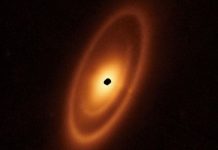
Sept. 20 (UPI) — With the help of the ALMA observatory, astronomers have captured images of a smoky bubble of debris expelled by the unusual red star, U Antliae.
U Antliae is a carbon star, a type of luminous red giant noted for its sooty-looking, carbon-rich atmosphere and rub red appearance. Over the last several thousand years, U Antliae has experienced a dramatic evolution, rapidly shedding mass and, most recently, expelling a shell of material at extreme speed.
The impressive resolution of the new image was made possible by the ability of the ALMA radio telescope to field multiple wavelengths. In addition to making for a stunning image, ALMA’s multi-wavelength dataset can also be used to slice through the bubble and study the debris shell in 3D.
The Doppler effect allowed astronomers to measure the direction and velocity of different slices of the bubble.
The smoky shell is surprisingly thin and round. ALMA’s analysis also revealed wispy filamentary substructures within the bubble of dust and gas.
Analysis U Antliae can help scientists better understand how aging star evolves, as well as how their mass loss offers fresh star-making material to new stars and new galaxies.
“Shells such as the one around U Antliae show a rich variety of chemical compounds based on carbon and other elements. They also help to recycle matter, and contribute up to 70 percent of the dust between stars,” researchers wrote in a news release.
Scientists detailed their analysis of U Antliae in a new paper, published this week in the journal Astronomy and Astrophysics.





